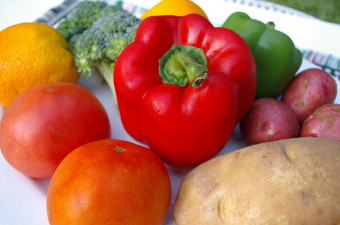
A Dozen Ways to Get Your Vitamin C
By Thursday Review staff
By now most folks know that Vitamin C is one of the essential dietary elements—a sort of miracle Vitamin which, most famously of all, helps the human immune system fight off common ailments like colds, flus and minor infections. Vitamin C has also been widely credited with the ability to help reduce or minimize symptoms related to these same routine problems.
But doctors believe that Vitamin C has literally dozens of other important functions in the body. For one, it is a prominent antioxidant—and according to some recent research, that means that Vitamin C may help bolster the body’s resistance to certain forms of cancer. Furthermore, Vitamin C has also long been known to reduce skin conditions, improve absorption of iron in the body, speed recovery from tissue damage and wound healing, and may even prove important in the resisting glaucoma and cataracts. Studies have also shown that Vitamin plays an important role in preventing cardiovascular disease. All-in-all, a pretty handy toolbox in a single dietary substance.
According to both the Centers for Disease Control and the National Institutes of Health, Vitamin C is an all-around disease-fighter. In many major studies, those who add the recommended amount of Vitamin C to their diet—either through foods or through a supplement—greatly reduce their risk of infections and disease, and the evidence regarding Vitamin C’s role in cancer prevention and treatment has grown in recent years. Furthermore, Vitamin C is absorbed into the body quickly and efficiently—almost all of it is put to use, and any quantities not needed are simply ejected through urine or bodily fluids.
The best news of all is that Vitamin C can be found in a wide variety of tasty foods. Most people already know that most citrus fruits are packed with Vitamin C, and that list includes oranges, nectarines, tangerines, grapefruit, lemons and limes. Similarly, Vitamin C can be absorbed easily through orange juice and grapefruit juice.
But did you also know that Vitamin C can be found in abundant quantities in red peppers and green peppers? Even when shredded or sliced for modest use in a salad, peppers contain so much Vitamin C that you will get almost 100% of the recommended allowance in a single serving. Peppers can also be cooked to perfection on the grill, diced and used in other cooked veggies, steamed alongside squash or zucchini, added as a topping to pizza, or (if you have the moxie) just eaten raw.
Another surprisingly rich source of Vitamin C is kiwifruit, a single serving of which contains over 100% of the recommended daily intake. Kiwi, like oranges and grapefruits, can be eaten chilled or at room temperature as a snack anytime, day or night. Strawberries and cantaloupe are also potent sources of Vitamin C, and side-by-side single servings of each have enough C to easily meet your daily requirement—plus they are delicious and require almost no preparation. Blueberries are also high on the Vitamin C list. And many health advocates recommend cutting open a lime each day, and squeezing the contents into a single glass of water, or, into a water bottle; a serving of lime can contain up to 33% of the desired intake of Vitamin C. For the same reason, recipes which include the use of limes or lime juice will help your diet include a bigger share of Vitamin C.
What about vegetables? Among the veggies with high Vitamin C content is broccoli—great steamed as a side dish, raw as a snack, or chopped and added to salads. Not only is broccoli packed with Vitamin C, it is also a high fiber food believed to be a cancer-inhibitor for its antioxidant qualities. Similarly, Brussels sprouts, cauliflower and cabbage are all rich in Vitamin C, and, like broccoli, contain many other qualities which may help to ward of the development of internal cancers. Sweet peas and English peas are also loaded with Vitamin C.
Did you know that a baked potato contains 17 milligrams of Vitamin C, or 28% of the recommended allowance? A meal which includes one medium-sized potato, alongside a serving of spinach, a small serving of English peas or sweet peas and two slices of raw tomato will contain over 100% of the Vitamin C you require in a single day. For that matter, nearly any combination of the foods listed in this article—breakfast, lunch, supper or snack—can ensure that you get enough Vitamin C in your daily diet.
All of this means that the average person can—with relative ease and convenience—pack 100% of the recommended amount of Vitamin C into your body each day, and it can be done using a surprisingly versatile, inexpensive and tasty grocery list.
Related Thursday Review articles:
Tasty Ways to Reduce Your Risk of Cancer; R. Alan Clanton; Thursday Review.
The Health Magic of Berries; Maggie Nichols; Thursday Review.
